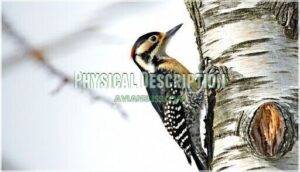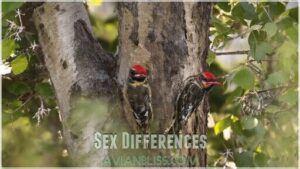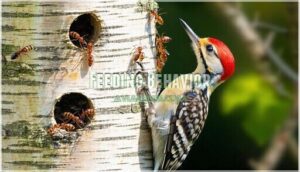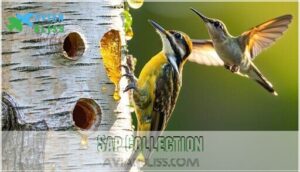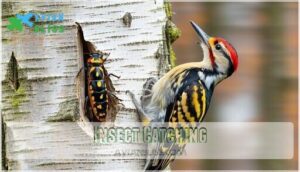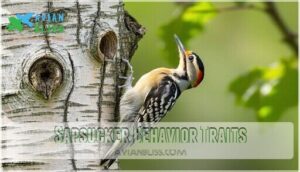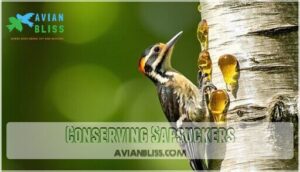This site is supported by our readers. We may earn a commission, at no cost to you, if you purchase through links.
 You’ll recognize a yellow bellied sapsucker by its bold black-and-white striped face, bright red forehead, and characteristic feeding behavior.
You’ll recognize a yellow bellied sapsucker by its bold black-and-white striped face, bright red forehead, and characteristic feeding behavior.
Unlike other woodpeckers that hunt insects, this species drills neat rows of quarter-inch holes in tree bark to harvest sap.
Males sport red throats while females have white throats, and both show a subtle yellow wash on their bellies.
These medium-sized woodpeckers prefer deciduous and mixed forests, making them one of the few migratory woodpecker species in North America.
Their methodical sap-drilling creates lasting evidence of their presence, often benefiting other wildlife that feed on the flowing sap and attracted insects.
Table Of Contents
- Key Takeaways
- Yellow Bellied Sapsucker
- Sapsucker Diet Habits
- Sapsucker Habitat Preferences
- Sapsucker Behavior Traits
- Conserving Sapsuckers
- Frequently Asked Questions (FAQs)
- What is the difference between a yellow-bellied sapsucker and a woodpecker?
- Are yellow-bellied sapsuckers bad for trees?
- Where can I find yellow-bellied sapsucker?
- How do you get rid of yellow-bellied sapsucker?
- What are the benefits of the yellow-bellied sapsuckers diet?
- Do yellow-bellied sapsuckers ever feed on the ground?
- How do yellow-bellied sapsuckers benefit other species?
- How does climate change impact this bird?
- How long do yellow-bellied sapsuckers live?
- When do sapsuckers typically begin breeding season?
- Conclusion
Key Takeaways
- You’ll identify yellow-bellied sapsuckers by their bold black-and-white striped face pattern, red forehead, and distinctive white wing stripe – males have red throats while females show white throats
- You can spot their unique feeding behavior through neat rows of quarter-inch holes drilled in tree bark to harvest sap – unlike other woodpeckers that primarily hunt insects, these birds create lasting evidence of their presence
- You’ll find them in deciduous and mixed forests during migration seasons – they’re one of the few migratory woodpecker species in North America, traveling from northern breeding grounds to southern wintering areas
- You’ll discover they benefit entire forest ecosystems by creating sap wells that attract hummingbirds, squirrels, and other wildlife – their drilling activity establishes natural feeding stations while causing minimal harm to healthy trees
Yellow Bellied Sapsucker
You’ll recognize this distinctive woodpecker by its mottled black and white plumage with a vertical white wing stripe and subtle yellowish underparts.
This medium-sized woodpecker’s striking black-and-white patterns and red markings make identification remarkably straightforward.
The species measures 7-9 inches long with males displaying bright red foreheads and throats, while females show only red crowns with white throats.
Physical Description
You’ll recognize this medium-sized woodpecker by its distinctive bill shape and proportions.
The Yellowbellied Sapsucker measures 7-9 inches with a wingspan reaching 16 inches, placing it between Downy and Hairy Woodpeckers in size comparison.
Their straight, pointed bills and long wings create a streamlined silhouette.
Feather patterns include mottled black-and-white backs with yellowish underparts.
Juvenile plumage appears brownish before developing adult bird plumage characteristics.
Identification Features
When spotting a yellow bellied sapsucker, you’ll notice distinctive features that set it apart from other woodpeckers.
These size comparison markers and wing patterns make bird identification straightforward once you know what to look for.
- Vertical white stripe runs down the folded wing, creating unmistakable wing patterns
- Stout, straight bill shape differs from curved bills of other species
- Robin-sized body helps with size comparison against familiar birds
- Black-and-white face pattern with distinctive plumage variation between sexes
Colour Contrasts
The yellow bellied sapsucker’s color pattern creates striking contrasts that make field identification straightforward.
You’ll notice bold blackandwhite patterns across the wings and back, while the belly hue appears subtly yellowish rather than bright yellow.
| Feature | Male Plumage | Female Plumage |
|---|---|---|
| Forehead | Red forehead | Red forehead |
| Throat | Red throat | White throat |
| Wing Stripes | White vertical stripes | White vertical stripes |
| Juvenile Colors | Brownish with white patches | Brownish with white patches |
The provided table outlines the distinct features of the male and female plumage patterns, including forehead, throat, wing stripes, and juvenile colors, which are essential for accurate identification.
Sex Differences
Both male plumage and female plumage show striking differences in this woodpecker species.
Males display a vibrant red forehead paired with a matching red throat color that commands attention during breeding season.
Females share the same red forehead but feature a crisp white throat instead.
This throat color distinction makes bird identification straightforward when you’re observing north american birds.
Size variation between sexes remains minimal, though males often appear slightly more robust during territorial displays, which can be an important factor to consider for breeding season.
Juvenile Characteristics
Juvenile yellowbellied sapsuckers display distinct brownish coloration instead of adult patterns.
Young birds lack the striking red acquisition seen in mature woodpeckers, making bird identification challenging.
Their plumage differs substantially from adult woodpecker species during this maturation timeline.
Key juvenile characteristics include:
- Brownish head development replaces the bold black-and-white adult pattern
- White wing patches remain visible as primary identification markers
- Dull brownish plumage covers most body areas until late winter
- Red coloration develops gradually after their first winter season
Sapsucker Diet Habits
You’ll discover that Yellow-bellied Sapsuckers have a unique diet that sets them apart from other woodpeckers.
These specialized birds feed primarily on tree sap, insects, and inner bark, using their brush-tipped tongues to collect sweet sap from the neat rows of holes they drill in living trees, which is a unique aspect of their behavior.
Food Sources
The sapsucker diet features diverse food sources that sustain these specialized birds throughout the year.
You’ll find sap composition varies by tree species, with maples and birches providing the sweetest nutrition.
| Primary Foods | Secondary Foods |
|---|---|
| Tree sap (20% of diet) | Native berries and fruit |
| Insects (beetles, ants, moths) | Seeds and nuts |
| Cambium (inner bark) | Trapped prey from sap wells |
Well sharing occurs when other species exploit sapsucker holes.
This sapfeeding bird’s diet shifts seasonally, with insect prey dominating summer months while sap sustains them during migration.
Feeding Behavior
You’ll notice sapsucker feeding behavior follows predictable patterns throughout the day.
Their specialized tongue adaptation allows efficient sap collection while their insect diet supplements nutritional needs.
Tree selection depends on sap flow quality and accessibility.
Notably, sap wells attract insects for additional foraging opportunities.
- Strategic timing: Sapsuckers feed most actively during morning hours when sap pressure peaks in trees
- Territorial circuits: Individual birds maintain regular feeding routes between 20-40 sap wells across their territory
- Mixed foraging: They alternate between lapping sap and catching insects attracted to the sticky wells
Sap Collection
Where does this sapsucker bird find its liquid gold? You’ll discover sap well creation happens on over one thousand tree species, though birch and maple trees remain top choices.
These sapfeeding birds drill shallow rectangular holes and deeper round ones. The sap composition provides essential sugars and nutrients.
Species benefit includes hummingbirds and squirrels accessing these sap wells. Sap collection impact remains minimal on healthy trees, making it a relatively harmless activity for the trees, with the birds relying on the essential sugars.
Insect Catching
How do these sapsucker birds catch their insect prey beyond sticky sap traps?
The woodpecker uses specialized tongue barbs to snag insects from tree bark crevices and sap wells.
- Tongue barbs: Rearward-facing spines catch beetles and ants effectively
- Prey variety: Moths, dragonflies, and larva consumption supplements bird diet
- Insect abundance: Peak feeding occurs during spring emergence periods
- Sap wells: Function as natural sticky traps for unsuspecting insects
- Active hunting: Sapfeeding birds probe bark for hidden insect colonies
Sapsucker Habitat Preferences
You’ll find Yellow-bellied Sapsuckers thriving in deciduous and mixed forests where maple, birch, and aspen trees provide their preferred sap sources.
These migratory woodpeckers breed in northern boreal forests from Canada to the northeastern United States, then travel remarkable distances to winter in the southern U.S., Central America, and the Caribbean, making them a notable example of remarkable endurance.
Forest Types
You’ll find Yellow-bellied Sapsuckers thriving in diverse forest compositions across North America.
These woodlands range from pure deciduous trees to mixed coniferous woods, with aspen groves providing ideal habitat conditions.
Regional variations influence their preferences – northern populations favor boreal forests while southern birds select temperate woodlands.
Forest health and climate influence directly impact tree density and overall habitat quality for successful sapsucker populations, which is crucial for their survival in diverse forest compositions.
Tree Preferences
Maple trees hold the sapsucker’s heart with their sap sweetness, though these birds aren’t picky eaters.
You’ll spot their neat sapsucker holes in over 1,000 tree species, from aspen to paper birch and yellow birch.
Forest composition matters less than individual tree health and species selection, as healthy specimens produce the richest sap wells that attract these specialized woodpeckers.
Migration Patterns
Unlike many bird species that stay put year-round, these woodpeckers undertake impressive journeys spanning up to 2,500 kilometers.
Migration timing follows predictable patterns, with spring departure from wintering locations beginning in late March.
Sex segregation occurs during migration, as males and females follow different routes to distinct destinations, creating fascinating stopover ecology dynamics that showcase remarkable bird behavior adaptations.
These journeys are often guided by established migration flyways, which provide essential routes, and are part of remarkable bird behavior adaptations, influenced by predictable patterns.
Wintering Grounds
Yellow-bellied sapsuckers set out on Southern Migration each fall, with males and females showing distinct Habitat Selection patterns.
Males typically winter in southeastern states, while females venture further into Central America—a phenomenon called Sex Segregation.
Climate Impacts increasingly affect traditional bird migration routes and Resource Availability.
Consider suitable winter shelters for sapsuckers.
- Hardwood forests dotted with wounded maples dripping golden sap
- Urban parks where hummingbird feeders offer sweet winter treats
- Wetland edges lined with berry-heavy dogwood and holly trees
- Fragmented woodlands stretching from Virginia’s coast to Texas Gulf shores
Sapsucker Behavior Traits
You’ll discover that Yellow-bellied Sapsuckers exhibit fascinating behaviors that set them apart from other woodpeckers.
These unique birds communicate through distinct drumming patterns and display complex social interactions throughout their seasonal cycles.
Drumming Behavior
When you hear a Yellow-bellied Sapsucker‘s drumming behavior, you’ll notice its distinctive rhythm differs from other woodpeckers.
These bird behavior patterns create rolling sequences followed by slower taps. Drumming frequency increases during breeding season for mate communication.
The drumming mechanics involve striking resonant surfaces like dead trees or metal objects. Drumming variations include different rhythms for territorial claims versus courtship.
This woodpecker’s drumming sounds serve multiple purposes beyond simple bird calls, establishing territory and attracting mates through these unique bird sounds. Some species also use drumming as territorial defense.
Nesting Habits
Cavity construction begins when sapsuckers select dead or dying trees for nest location.
These woodpeckers excavate deep nest cavities, typically 8-15 inches down into the trunk. Both parents share excavation duties over 2-3 weeks.
The female lays 3-7 white eggs inside the cavity. Incubation period lasts 12-13 days, with both adults taking turns.
Fledgling care continues for several weeks after hatching, as parents feed insects to growing chicks during the incubation period.
Social Interactions
During breeding season, you’ll witness fascinating social interactions that reveal complex behavior patterns among Yellow-bellied Sapsuckers.
These birds establish clear dominance hierarchies and engage in intricate mating displays that strengthen pair bonds.
Key social behaviors include:
- Sap Well Sharing – Multiple species benefit from sapsucker wells, creating unique interspecies relationships
- Territorial Defense – Males aggressively guard prime feeding territories through physical displays
- Courtship Rituals – Elaborate mating displays involve synchronized drumming and ritualized feeding exchanges
Communication Methods
Drumming signals serve as the sapsucker’s primary long-distance communication method. You’ll hear their distinctive rolling knocks followed by slower taps during breeding season.
These woodpeckers also produce nasally mewing calls and other vocalizations for close-range interactions. Visual cues include crown feather displays and positioning near sap wells.
This interspecies communication attracts hummingbirds and other species to their feeding sites.
Conserving Sapsuckers
You’ll discover that Yellow-bellied Sapsuckers play a vital role in forest ecosystems, and understanding their conservation needs helps protect both the birds and their woodland homes.
Creating the right habitat conditions can attract these fascinating woodpeckers to your area while supporting their unique feeding behaviors.
Impact on Trees
You’ll find that sapsuckers create minimal tree damage through their feeding habits.
Their sapsucker holes don’t directly harm healthy trees, though they can introduce fungal infections through open wounds.
These woodpeckers show strong tree species preference for maples and birches.
Sapling vulnerability increases compared to mature trees, and the cambium layer heals quickly, and long-term effects remain negligible for most tree trunks.
Conservation Status
You’ll be relieved to know Yellow-bellied Sapsuckers aren’t facing extinction. Their conservation status shows promising stability across North America’s forests.
Current population trends indicate these specialized woodpeckers maintain healthy numbers despite environmental pressures. The species benefits from legal protections under migratory bird treaties, ensuring their continued presence in our forests.
Some key statistics about their population include:
- Over 9 million breeding pairs documented across their range
- Population trends remain stable or slightly increasing in most regions
- Climate change poses future challenges to northern breeding habitats
- Habitat loss from deforestation affects local populations
- Conservation efforts focus on protecting boreal forest ecosystems
Attracting Sapsuckers
You can easily attract these fascinating woodpeckers to your yard with the right approach.
Focus on offering suet, grape jelly, and hummingbird nectar at feeders during migration periods. Sapsuckers are more likely to visit if you use DIY jelly feeders.
| Feeder Type | Best Attractants |
|---|---|
| Suet feeders | Peanut butter suet, bird puddings |
| Jelly feeders | Grape jelly in oriole-style feeders |
| Nectar feeders | Sugar water in hummingbird feeders |
| Seed feeders | Sunflower hearts in finch feeders |
| Fruit offerings | Fresh apples, serviceberries |
Peak attraction occurs from late September through April when sapsuckers migrate through or winter in southern regions, making this the ideal time for consistent birdwatching success.
Creating Sapsucker Friendly Habitats
Creating bird habitats that support Yellow-bellied Sapsuckers requires thoughtful tree selection and nesting assistance.
Plant native birch, maple, and aspen trees to provide essential sap sources. Consider buying these trees to enhance the habitat.
Maintain standing deadwood for cavity excavation while ensuring adequate water sources nearby.
Boost insect abundance by avoiding pesticides and preserving leaf litter.
Provide winter shelters through dense coniferous plantings that offer protection during migration periods.
Frequently Asked Questions (FAQs)
What is the difference between a yellow-bellied sapsucker and a woodpecker?
Yellow-bellied sapsuckers are actually a specific type of woodpecker.
They’re distinguished by their unique sap-drilling behavior, migratory habits, yellowish underparts, and distinctive white wing stripes that separate them from other woodpecker species.
Are yellow-bellied sapsuckers bad for trees?
Like gentle rain that nourishes rather than floods, you’ll find sapsuckers create minimal tree damage.
Their shallow sap wells don’t kill healthy trees, though they may introduce minor fungal infections occasionally, which can be considered a minor issue.
Where can I find yellow-bellied sapsucker?
You’ll find these migratory woodpeckers in deciduous and mixed forests across eastern North America. They breed in Canada and northeastern U.S., then winter from southern states to Central America.
How do you get rid of yellow-bellied sapsucker?
You can’t entirely "get rid of" Yellow-bellied Sapsuckers since they’re protected migratory birds.
Instead, discourage them by wrapping damaged trees with burlap, installing reflective tape, or providing alternative perching sites away from valuable trees.
What are the benefits of the yellow-bellied sapsuckers diet?
You’ll benefit from their balanced diet that includes sap, insects, fruits, and tree nutrients.
This diverse feeding creates sap wells that attract other wildlife like hummingbirds, providing ecosystem services while controlling pest insects naturally.
Do yellow-bellied sapsuckers ever feed on the ground?
While 95% of their foraging occurs on tree trunks and branches, you’ll occasionally spot yellow-bellied sapsuckers on the ground.
Picking up fallen fruits, nuts, or insects that’ve dropped from their aerial hunting spots above is another aspect of their foraging behavior, showcasing their adaptability in searching for food.
How do yellow-bellied sapsuckers benefit other species?
You’ll discover they create sap wells that become feeding stations for hummingbirds, nuthatches, chickadees, kinglets, bats, squirrels, and insects. Their drilling work basically sets up a neighborhood buffet system.
How does climate change impact this bird?
Like a canary in a climate mine, you’re witnessing early warning signs.
Climate models predict an 88% loss of breeding habitat by 2080, forcing migration timing shifts and habitat disruptions.
This species inhabits the northern hardwoods biome.
How long do yellow-bellied sapsuckers live?
You’ll typically live 6 to 8 years when you’re observing these woodpeckers in the wild. The maximum recorded lifespan is around 8 years, though some sources suggest they average closer to 7 years.
When do sapsuckers typically begin breeding season?
Breeding season starts when you’d expect – males arrive in May, often before females, and begin courtship displays and nest excavation from April through July.
Conclusion
Mastering yellow bellied sapsucker identification transforms you into an absolutely unstoppable birding detective.
You’ll confidently spot these unique woodpeckers by their distinctive black-and-white facial stripes, red foreheads, and methodical sap-drilling behavior.
Remember that males display red throats while females show white throats.
Their neat rows of holes in tree bark create lasting evidence of their presence.
Understanding yellow bellied sapsucker habits helps you locate them in deciduous forests during migration seasons and appreciate their essential ecological role.
You will be able to confidently spot them and understand their methodical sap-drilling behavior.
- https://ncwf.org/blog/yellow-bellied-sapsucker/
- https://deepblue.lib.umich.edu/bitstream/handle/2027.42/54740/3181.pdf
- https://georgiawildlife.com/out-my-backdoor-yellow-bellied-sapsuckers
- https://backyardwildlifeconnection.com/2016/12/09/a-yellow-bellied-sapsucker-feeder/
- https://newlingristmill.org/cornelius-corner-getting-a-sugar-buzz-with-yellow-bellied-sapsuckers/

